Welcome to Close Reads! In this series, Leah Schnelbach and guest authors will dig into the tiny, weird moments of pop culture—from books to theme songs to viral internet hits—that have burrowed into our minds, found rent-stabilized apartments, started community gardens, and refused to be forced out by corporate interests. This time out, writer and Marvel editor Sarah Brunstad slaps headphones on our ears and creeps us all the hell out with Colin Stetson’s soundtrack to Hereditary.
“It’s something we have to either make peace with or not.”
Ari Aster was referring to the fear of death and the unknown, but I haven’t heard a better thesis statement for Aster’s feature film directorial debut, the 2018 horror film Hereditary, whose peace with the devil now resonates with America’s own, very real, demonic possession by the hand of a pandemic demon.
As the film begins, viewers are led to believe that the Graham family, haunted by various forms of grief, is unraveling into violent paranoia. It’s only after the entire family is either dead or possessed beyond return that we’re finally let in to the reality of the Paemon cult, and its spiritual stalking of the Grahams over many generations. The film turns in its final third from a narrative of grief—particularly that of mother Annie, who begins the film at her own mother’s funeral and must suffer through her daughter’s death soon after—to a narrative of demonic, campy possession. There was nothing the Grahams could have done to prevent their fate; by the time the film starts, Paemon is already inside the youngest child, Charlie, and the cult’s machinations set far in motion. Commenting for Vulture, Aster said he “wanted there to be a sense that the film knows where this is all going and knows where this has to go—that there’s this feeling of the inevitable,” an affect produced in part by Colin Stetson’s droning soundtrack. Together Aster and Stetson ensure that the film’s scariest moments are ones that step just beyond the visceral expectation. Stetson’s sounds lurk in the backgrounds, often lingering long past the emotional conclusion to an event.
In one of the film’s early cues that something is not quite right, Charlie—Paemon’s first vessel for possession—stares straight ahead at her schoolroom desk. Her profile breathes anxiety; a teacher has just told her to put down her doll (that classically menacing effigy of unknown antecedent) and finish a quiz. A dark shadow flits almost unnoticed through the corner of the screen. WHAM. A blackbird suicide-dives into the schoolroom window, prompting screams and scrambling while Charlie herself continues to stare ahead, unsurprised and indifferently triumphant.
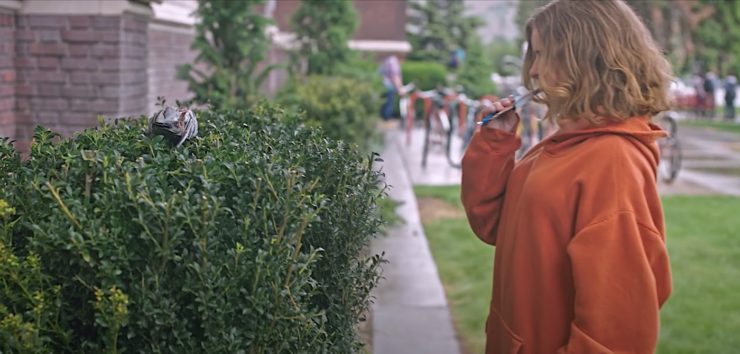
Then music begins. It’s a small subversion of the jumpscare formula, where the music generally functions as a lead, a leitmotif drawing attention to the impending shock. But here a rise of tremolo strings draws us away from the bird’s death, and Stetson’s drone pitch rises against the camera’s slow focus on Charlie and the object of her desire (the scissors she’ll use in the next scene).
For fans of Stetson’s music, much of Hereditary’s soundtrack will be familiar. A saxophonist and composer, Stetson often uses his primary instrument as a multi-tonal machine, splitting his embouchure to play two tones at once, or “split tones,” that dance in and out of tonal concordance. While doing this, Stetson also employs a technique called circular breathing, in which the wind instrument player is able to both breathe in and play out simultaneously—something that requires years of strained practice to master with so much tonal control. The listener is left wondering, Is this guy gonna breath? On top of this breathing, he adds a self-designed throat mic that picks up his growling (vocalizing—think singing or screaming—into the instrument) and additionally distorts it.
The combined effect—of an immortal breath delivering the saxophone, punctuated by growls that sometimes sound like a mummy shouting its way out of a tomb—is one that fans have called “claustrophobic.” In fact, citing its effects, multiple audience members have fainted at his live shows.
Stetson’s film score mixes his signature technique into a multi-instrumental fabric of exhaustive drone. Charlie, now outside the schoolroom window, finds the bird’s stiff form atop a meticulous hedge. First the frame of the dead bird, and then her enigmatic theme song, processing the death. A percussive heartbeat breathed by woodwinds accompanies a thin scraping of strings and Stetson’s saxophone long tones, all buried beneath a layer of ambient electronic drone. The layering pulls us deep, creating an almost underwater effect, while, on screen, Charlie slowly cuts off the bird’s head with that pair of classroom scissors. And again Stetson subverts expectation: the sound builds to the bird’s beheading and then continues, the menace unfinished though the act of violence is done. There is no pause for breath. A low roar follows Charlie’s gaze to the parking lot across the street, where a stranger—a clean, seemingly normal woman of grandmothering age, a follower of Paemon never identified—lifts her hand in a shy wave. It’s weird, and kind of funny? Though the film hasn’t yet revealed it, the cult, not the family, is instigating these acts of horror. The music’s uncanny lack of breath evokes this omniscient cult presence.

In this subversion of scariness, this movement away from choice—no one in Hereditary has agency, as Paemon’s victory is claimed before the film even begins—I found unexpected humor. I laughed when Charlie’s head smacks into the post on a deserted road and rolls clean off. When Annie floats over her son in the dark attic, repeatedly stabbing herself in the neck with a wet-corn shucking sound. When, in the same scene, Peter hears the single ting! of a bell and turns to see a trio of naked geriatrics, smiling and waggling ancient fingers at him. The humor was jarring in the theaters, where I had entered expecting a psychological horror film more interested in the interiority of a grieving woman than the many ways the outside world can make her bleed.
I do not mean to say that Stetson’s soundtrack (or the film) is, itself, even remotely comedic. It’s spooky listening, especially in old houses with voices of their own. But in revisiting the soundtrack (which I did, with every light turned on, in an old house with voices of its own), I found his collaboration with Aster cathartic in new ways, as I permitted myself a loosening of what I was looking for in a thoughtful horror film. I had looked for agency where there was none. I had blamed Annie for her family’s dissolution, for her myopic perspective of the family unit from within the tight, literally handbuilt frames of her own memories through the dioramas she constructs throughout the film. How tragic, how absurd, her attempts to escape the house she thought she was building.
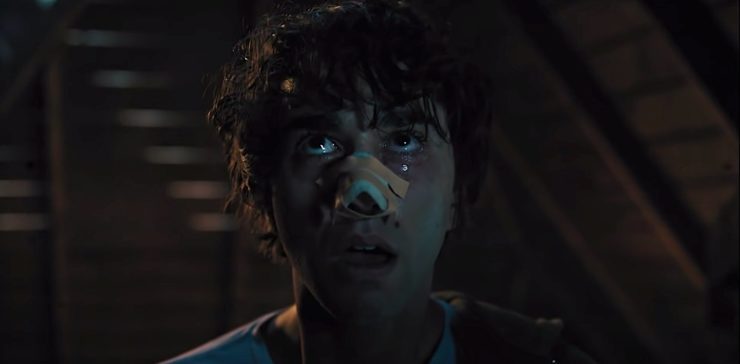
Stetson brings it all home in the soundtrack’s final pieces, the heavenly “Reborn” and darkly meditative “Hail, Paemon!” In “Reborn,” redolent strings soothe trilling wood sounds and join the dark choir that continues into “Hail, Paemon!”. Tinkling bells fall back under Stetson’s double-breathed sax and throat instrument. It is the most orchestral of all the soundtrack’s range, and indeed listens, in isolation, like an angelic triumph.
Hereditary leaves me uneasy with interiors—and certainly cults have been on the mind. There are many people, some in positions of power, some with sizable media platforms, who spread disinformation and accuse their political opponents of child trafficking and other horrors. And living in America right now, as we deal with the continued aftermath of the last few years, has often felt like living in the grip of a cult of greed and violence. Now new variations of COVID-19 pummel Americans forward into the possibility of another winter locked inside. “It’s something we have to either make peace with or not.” And, well, the music goes on.
Sarah Brunstad is an editor for Marvel Comics. Find her on Twitter @MightyBrunstad.


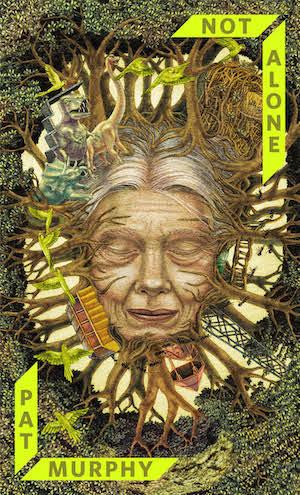
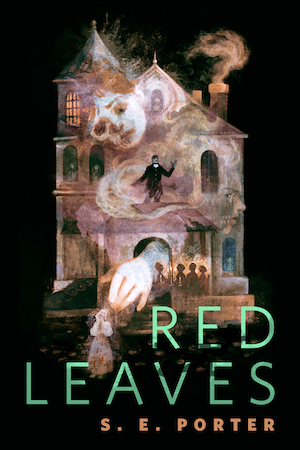






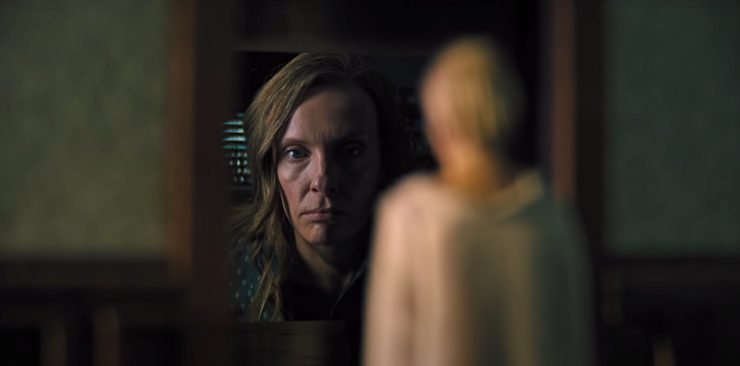
There’s The Space Eater by Dave Langford, in which meddling with the laws of physics in ways that are technologically useful causes many stars to go nova, all at once. Fortunately that doesn’t include Sol, but to avoid further meddling having that effect strict limits are placed on the future use of anomalous physics, restricting traversable wormholes to a diameter of 1.9cm, which causes the protagonist some discomfort when he has to travel through one such wormhole.
Empire of the East is one of my favorite reads of all time. A truly marvelous work.
There’s always the Emberverse series by S. M. Stirling, which started with Dies the Fire. There’s a Wikipedia article at https://en.wikipedia.org/wiki/The_Emberverse_series
The backstory to Walter Jon Williams’ Ambassador of Progress involves an FTL drive that breaks the universe a bit:
God I’m getting old.
There was a bookstore in the twin towers, and I remember buying that copy of Ariel there, in part because of the twin towers in the background of the cover art. I remember buying a coffee and sitting outside in the sun and reading it. I remember nothing about the book itself, NOTHING.
“Of course, many authors have dabbled their feet in this particular pool. It would not take a brain wave to name several sterling examples, proved one did not zone out mid-sentence.”
I suppose stories with magic incorporated, or operations that deal with chaos (or at least tinker with it) would also qualify for this article?
An edge case (and good read): the Borderlands stories, in which Elfland does not quite overrun an anonymous North American city — with the result that neither magic nor physics works reliably. This is made especially explicit in Ford’s somewhat anticanonical(*) novel The Last Hot Time, in which there is discussion of the need to have two power plants (an internal-combustion engine and a magical something) in anything that is depended on for transport.
There’s also the Clarke story “Superiority”, in which one of the weapons stretches space; the theory is that a ship can move unseen to a remote area that becomes right next to enemy forces when space is unstretched, or can put enemy forces at a distance if outgunned. In practice it doesn’t work: unstretching doesn’t exactly reverse the process, meaning that a ship won’t wind up where it’s expected to and ships don’t quite get back to their original shape — so they can no longer use standard parts if something breaks.
(*) anticanonical because it takes place in Chicago (and speaks of many other cities as also having become edge zones), rather than a city that deliberately can’t be identified as any of the ones on our maps. It’s also not YA (as the series was intended to be), at least not by the standards of when it was published (2000).
The first Pocket Books Star Trek title, The Entropy Effect, had time travel breaking the universe, which had to be fixed
Rupert Sheldrake suggests there are no laws of physics, only habits. “Natural law” is a theological concept that was thoughtlessly incorporated into science.
Yoon Ha Lee’s Machinery of Empire series has the laws of physics changed, largely by a “consensus reality” forced by, among other means, mass torture.